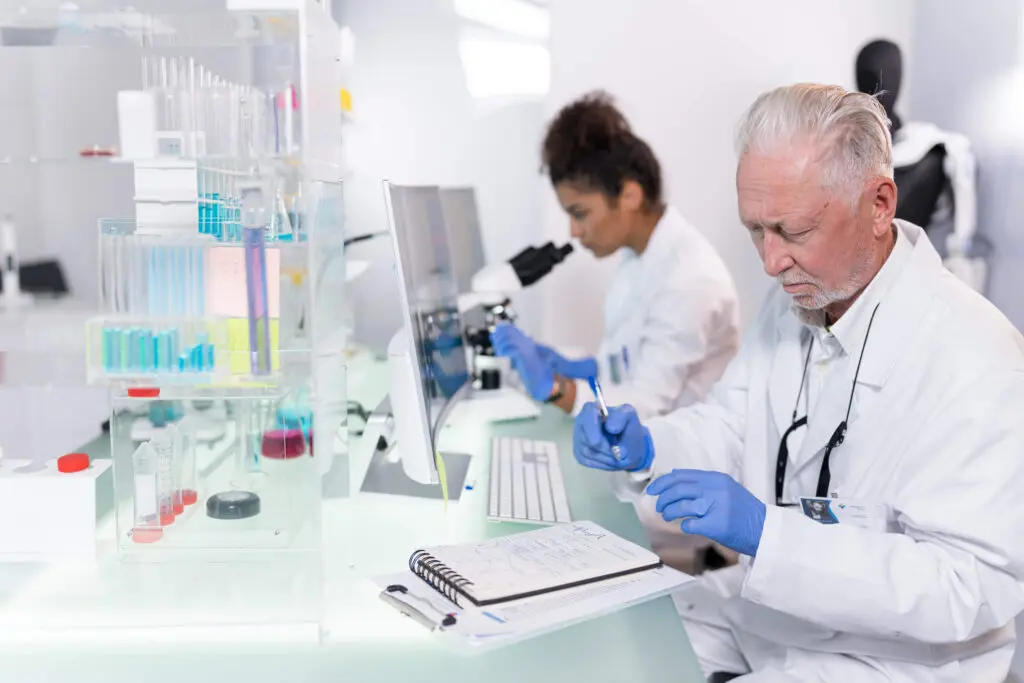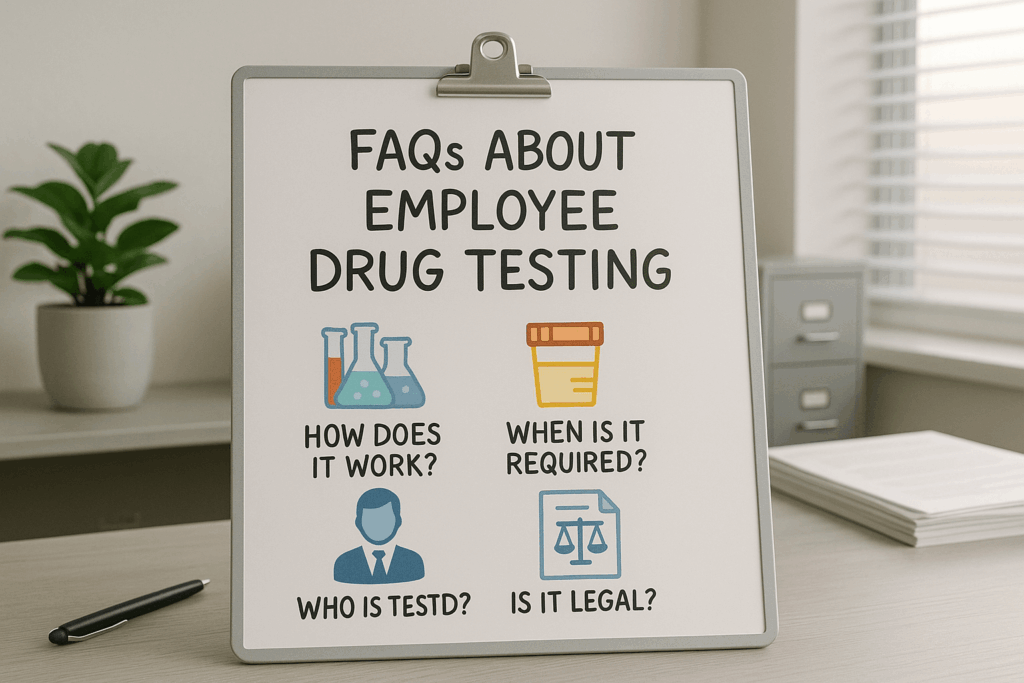Employee drug testing is critical to ensuring a safe and productive workplace environment. Pre-employment drug testing and random drug testing reduce the risk of workplace accidents and injury, and minimize turnover, absenteeism, and employee downtime.
In this blog, you’ll learn about the different types of employee drug testing, including urine, hair, saliva, and blood tests. We’ll explore the benefits and differences of each, which substances the tests identify, employee rights and employer responsibilities, and more.
![]() Key Takeaways
Key Takeaways
- Employee drug testing promotes workplace safety and reduces absenteeism.
- There are four main testing types: urine, hair, saliva, and blood.
- Urine tests are quick and affordable, detecting recent drug use.
- Hair tests offer long detection windows—up to 90+ days.
- Saliva and blood tests provide fast, accurate results.
- Tests screen for THC, cocaine, opioids, amphetamines, and alcohol.
- Employers must follow legal procedures and protect privacy (HIPAA, ADA).
- Results may be affected by metabolism, dosage, and frequency of use.
- Employees must be informed and give consent during pre-employment drug screening.
Table of Contents
Types of Drug Tests
Some of the most common workplace drug testing methods are urine, hair, saliva, and blood tests.
Urine Tests
Urine tests are simple to administer, painless, and cost-effective. Results are available within just a few days and, in some cases, in a single day.
However, there is a small window for detection. Traces of drugs typically leave the human system relatively quickly—within five to 10 days. Therefore, urine tests will only pick up evidence of drug use within a few days of drug use.
Hair Tests
Hair follicle drug testing is considered the most accurate form of testing. Drugs and metabolites remain in hair as it grows, so the window for detection is much longer than for a urine test. Detection times range from three months for scalp hair to up to a year for body hair.
Hair tests are also highly sensitive and can detect a wide range of substances. Hair follicle testing is useful for picking up the use of cocaine, amphetamines, opioids, methamphetamines, PCP, and other drugs.
Saliva Tests
Like urine tests, saliva tests detect drugs within a short timeframe—typically within 48 hours. They’re a useful backup option to urine tests if a person fails to produce enough urine.
The Department of Transportation (DOT) has authorized saliva testing as part of its DOT drug testing program. Employers and other industries can decide whether to use a urine or saliva test in their pre-employment drug screening processes.
Blood Tests
Blood tests are very accurate but can be expensive and difficult to administer. Many employees are hesitant to submit to a needle, and some may not be able to do so due to underlying medical conditions.
Still, comprehensive five-panel blood tests can detect a vast range of drugs, and results can be had in minutes rather than days. They are a good option for employers who need results quickly.
Common Substances Screened

Workplace drug tests are designed to screen for a wide range of drugs, including tetrahydrocannabinol (THC), cocaine, opiates, amphetamines, and alcohol.
The Drug Testing Process
Employers should follow a strict and set process for employee drug testing. The process involves:
Sample collection. Samples are collected in safe and sterile environments. Collection is overseen by a Medical Review Officer (MRO), a licensed physician responsible for administering, receiving, reviewing, and analyzing drug tests.
Specimen handling. Once the sample is collected, the MRO follows a specific protocol to make sure the specimen is handled correctly and kept safe from contamination. Handling involves safely transferring the specimen to a laboratory where it can be analyzed.
Specimen analysis. After arriving at the lab, the MRO analyzes the specimen, resulting in either a positive or negative result.
Pre-Test Procedure
Prior to the collection and distribution of the specimen, employees must undergo a pre-test procedure. The process might be slightly different for each employer, but typically involves the following steps:
- The employee must bring their government-issued photo ID with them to the testing site.
- The employee must fill out all relevant paperwork prior to the test.
- In cases of a urine test, the employee must drink the required amount of water beforehand—generally, 45 milliliters.
- For other tests, such as blood tests, the employee may be asked to fast for a certain period prior to the test.
During the Test
The sample collection procedure will differ depending on the test being performed:
- For urine testing, the employee urinates into a plastic container and provides the sample to an MRO.
- For blood testing, the MRO will extract a certain amount of blood from the employee. The process is usually quick and relatively painless.
- For hair follicle testing, the MRO will cut a few strands of the person’s hair, close to the scalp. The hair is usually cut from the back of the head, near the neck, so as not to leave any visible patches.
- For saliva testing, the MRO gently wipes the inside of the employee’s cheek or underneath their tongue with a cotton swab.
Post-Test Procedures
Once the sample arrives at the lab, the MRO uses a variety of methods to test for results. For example, urine drug testing usually involves a method known as gas chromatography-mass spectrometry (GM-MS) to identify various substances in a test sample.
Upon receiving the results, the MRO has 24 hours to attempt to contact the employee to let them know of their findings. If they can’t reach them, the MRO must contact their employer, who will attempt to contact the employee to set up a meeting to discuss the findings and determine next steps.
Understanding Test Results
Interpreting pre-employment drug test results is straightforward, as results will come back either positive or negative. However, results can be skewed due to several factors, including:
- Metabolism. Metabolism allows substances to be ingested into the body more quickly. A person with high metabolism is more likely to have a false positive drug test result.
- Drug half-life. Half-life is the amount of time a drug remains in a person’s system. Drugs with shorter half-life times are less likely to be detected on a test, particularly one that requires a shorter window of time, like a urine or saliva test.
- Frequency of drug use. Drugs that are used frequently are more likely to lead to a positive test result.
- Drug dosage. The higher a drug’s dosage, the more likely it will be detected with a test.
Legal and Ethical Considerations

Most states allow employers to test job applicants for drug or alcohol use, though laws can vary from state to state. Still, there are certain legal and ethical considerations employers must consider before administering an employee drug testing program.
Employee Rights
All employees have a right to know they will be subject to either pre-employment or random drug and alcohol testing. Job applicants must be made aware of the inclusion of workplace drug testing during the interview process.
Employees also have the right to privacy. Their health information must be protected as mandated by HIPAA and other laws such as the Americans with Disabilities Act.
Employer Responsibilities
Employers are responsible for maintaining the privacy of employees’ health information, including drug test results. All information must remain confidential. Drug tests should only be shared on a “need-to-know” basis.
Employers are also responsible for being transparent about their drug testing policies. They must clearly state those policies during the employee interview process.
Finally, employers are responsible for ensuring that specimen collection and analysis is handled by a certified Medical Review Officer.
FAQs About Employee Drug Testing

What do employers look for in a drug test?
An employee drug test is designed to look for evidence of drug and alcohol usage. The tests detect a wide range of drugs, including tetrahydrocannabinol (THC), cocaine, opiates, amphetamines, and alcohol.
What happens if you test positive for drugs at work?
A positive test will necessitate a meeting between employee and employer, during which the employer will determine what action, if any, to take. Action could include termination, leave of absence, commitment to a substance abuse program, and more.
How far back does a 10-panel urine test go?
Most urine tests will only detect drug usage that has occurred within the last five to 10 days.
The Importance of Employee Drug Testing in the Workplace
Employee drug testing is key to ensuring a safe, productive, and happy workplace. A drug-free workplace results in less absenteeism, fewer workplace injuries, and lower healthcare costs for employers. Private sector companies have the choice to implement drug testing programs, whereas public sector organizations, such as the Department of Transportation and others, require them.
Regardless of the organization or industry, Acuity International is here to help. Our comprehensive drug and alcohol testing services help organizations maintain drug-free environments.
Contact us to learn how we can help you and your employees.
